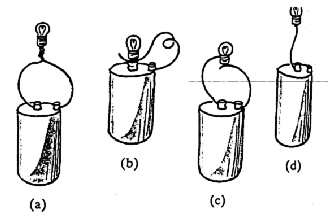P201 Menu
Exploratories
A Simple Electric Circuit
Purpose:
To demonstrate what is needed to produce a simple electric
circuit.
Materials:
1.5 to 6 volt battery; light bulb and socket; at least two
pieces of hookup wire.
Procedure:
1. Attach a piece of hookup wire to the battery and show that
the bulb will not light if the wire is attached to either terminal
of the light bulb or either terminal of the battery.

2. Attach two pieces of hookup wire to the battery, one to
each terminal. Show that
the bulb lights only when one wire is attached to one terminal
of the bulb and the other wire to the second terminal of the
bulb. Point out that in an electric circuit there must be a path
from the source to the appliance, through the appliance, and
back to the source. It often helps to point out that the word
circuit has the same root as the word circle.

Summing Up:
Because charge is conserved, current must flow equally in
all points of the circuit. The source receives as much current
at one terminal as leaves from the other.
D.C. Circuits Terms
Terms to define
circuit - a closed conducting path around which charge
or matter can flow.
current - the flow of electric charge or matter from
one place to another.
conventional current - conventionally taken to mean
that positive charge flows from a positive to negative direction;
in metals where only electrons flow, this is called negative
electron current.
EVERYDAY CONNECTIONS
Why won't your car start if one of the terminals falls off
the battery?
Discuss the ways that water currents are similar to electric
currents.
Electron Speed
When you turn the ignition key in an automobile, you complete
a circuit from the negative battery terminal through the electric
starter and back to the positive battery terminal. This is a
DC circuit and electrons migrate through the circuit in a direction
from the negative battery terminal to the positive terminal.
About how long must the key be in the ON position for electrons
starting from the negative terminal to reach the positive terminal?
a) A time shorter than that of the human reflex turning a switch
on or off
b) 1/4 seconds
c) 4 seconds
d) 4 minutes
e) 4 hours
Answer: Electron Speed
The answer is: e. Although the electrical signal travels
through the closed circuit at about the speed of light, the actual
speed of electron migration (drift velocity) is much less. Although
electrons in the open circuit (key in OFF position) at normal
temperatures have an average velocity of some millions of kilometers
per hour, they produce no current because they are moving in
all possible directions. There is no net flow in any preferred
direction. But when the key is turned to the ON
position the circuit is completed and the electric field between
the battery terminals is directed through the connecting circuit.
It is this electric field that is established int he circuit
at about the speed of light.
The electrons all along the circuit continue their random motion,
but are also accelerated by the impressed electric field in a
direction toward the end of the circuit connected to the positive
battery terminal. The accelerated electrons cannot gain appreciable
speeds because of collisions with anchored atoms in their paths.
These collisions continually interrupt the motion of the electrons
so that their net average speed is extremely slow--less than
a tiny fraction of a centimeter per second. So some hours are
required for the electrons to migrate from one battery terminal
through the circuit to the other terminal.

Complete Circuits
A simple electric circuit can be made with a dry cell, a lamp,
and some wire. In which of the arrangements shown will be lamp
be lit?

ANSWER: COMPLETE CIRCUITS
The answer is: c. A battery is not a source of energy which
fills lamp s in a sink-like fashion. There must be a current
"passing through" in the circuit. Current does not
flow into a lamp, nor does it even flow out of a lamp. Current
flows through a lamp, just as it does anywhere else in
the circuit, including the battery itself. Investigation of the
arrangements shows that only in c is a pathway
provided for the necessary in-to and out-of connection to the
lamp.



